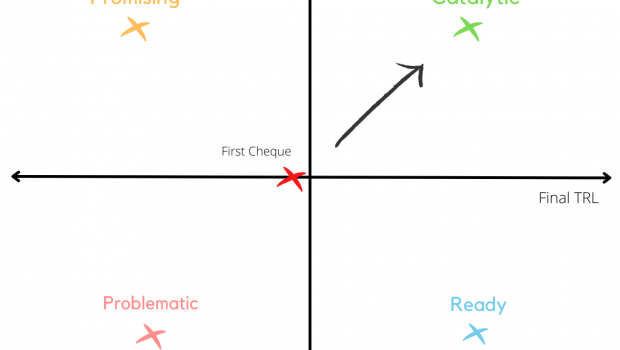Technology Readiness Levels : A System for Transparency | by Harikesh Pushpapathan | Stoic VC | Feb, 2022
Inventors often find it difficult to communicate their progress to external stakeholders such as grant programs, and especially investors without subject matter expertise. Without a clear narrative to buy into, investors will reject your project — even if there’s a young swan behind those ugly brown feathers.
Building a transparent partnership out of the gates is imperative and it begins with understanding Technology Readiness Levels (TRLs).
The acronym “TRL” was originally borne out of the Apollo program, the third spaceflight by NASA during the 1970s. It laid the foundations for an international standard for calibrating space system hardware: a way of evaluating whether the technology was ready for deployment. Today, TRLs are routinely used by investors to benchmark technical risk and understand the stage of a startup’s maturity.
The TRL scale encompasses nine levels, 1 being the least mature and 9 being commercially ready.
Here’s how it can be broken down [1].
TRL Scale
Simplified TRL Scale

Definitions
Fidelity = The level of detail & functionality of a prototype
Alpha prototype = Early design, not complete
Beta prototype = Representative of complete product
1. Communication
The TRL scale in its simplest form, is a tool for communication. It overcomes the common problem in science & engineering; that founders are often former academics and have been wired from day one to practice evidence-based thinking.
Hypothesis → Collect Data → Prove/Reject hypothesis
As a result, when pitching to investors, founders fall into the trap of selling the technicalities of the technology, rather than also selling the story. Without a story and a belief in where it is going, investors won’t think twice about your project. This is where TRLs comes into play, illustrated perfectly through a recent encounter of mine.
Last week I met a founder building in textile technology, and he was providing some scope into his project and the plan for the remainder of the financial year. I asked him the routine question — “what stage of development are you at? The first response I received was muddled with details of prototyping size, weight, coating alterations, discussions with retail chains — all of which made it more incomprehensible than before. So I instead rephrased my question to “what TRL do you classify your project at?” In a couple of seconds, I felt comfortable about the development level the core tech was at and the conversation flourished from there.
Whilst I’m not certainly claiming this to be the only marker of technological progress, using a standardised system like the TRL scale when talking to investors, means more time chatting about “what the business could be”, and less time about “what it is”. It makes the engagements more efficient and more likely to progress.
2. Tracking progression
Early-stage investors want to see progress from their technical teams, and this is often made difficult by time & resource constraints. Tracking TRLs can therefore be a standardised way of keeping partnerships aligned with their value creation over time. Here’s how I like to visualise it, based on a framework from [2].

The red cross marked in the above diagram is where we often begin our journey with founders at Stoic VC. At this stage, we require start-ups to have their core technology already working in the lab (mapping onto TRLs 5 to 6). Progression from here can vary widely by sector but it is a product of execution and fluctuating market dynamics. There are four scenarios that can play out:
1. Catalytic →Accelerating value creation, likely to exit
2. Promising →Value created over time, too early to sell
3. Problematic → Minimal value creation, too early to sell
4. Ready → Minimal expected return, likely to exit soon.
The fundamental goal as investors is to partner with founders looking to build catalytic technologies. These are technologies which materialise into commercially viable products but more importantly accelerate change in valuation. Companies which fall into the ‘ready’ quadrant, harbour technologies that are indeed likely to exit, but will not give us a large multiple on our investment. Tracking TRLs over time is one way to visualise value creation and whether you’re moving closer or away from retiring technical risk as an investor.
1. TRL’s don’t consider all critical developmental activities

There are at least three primary risks which should accompany each level of the TRL scale in order to fully gauge progress and value creation (As labelled above).
e.g. At TRL 4, founders should have:
a) Developed basic P&L (incl. non diluting financing, impact of design on cost & integration of core technology) ready for investors
b) Understood key metrics needed to be commercially viable.
c) Confirmation of willingness-to-pay (WTP) by users.
2. A TRL is subjective
TRLs were borne out of space programs, so outside applications will have ambiguity. This can stem from various sources including:
a) Developing multiple component technologies in parallel
or
b) Founders overestimating the maturity of their tech (due to supply chain dynamics, competition for resources, natural bias)








Gloss